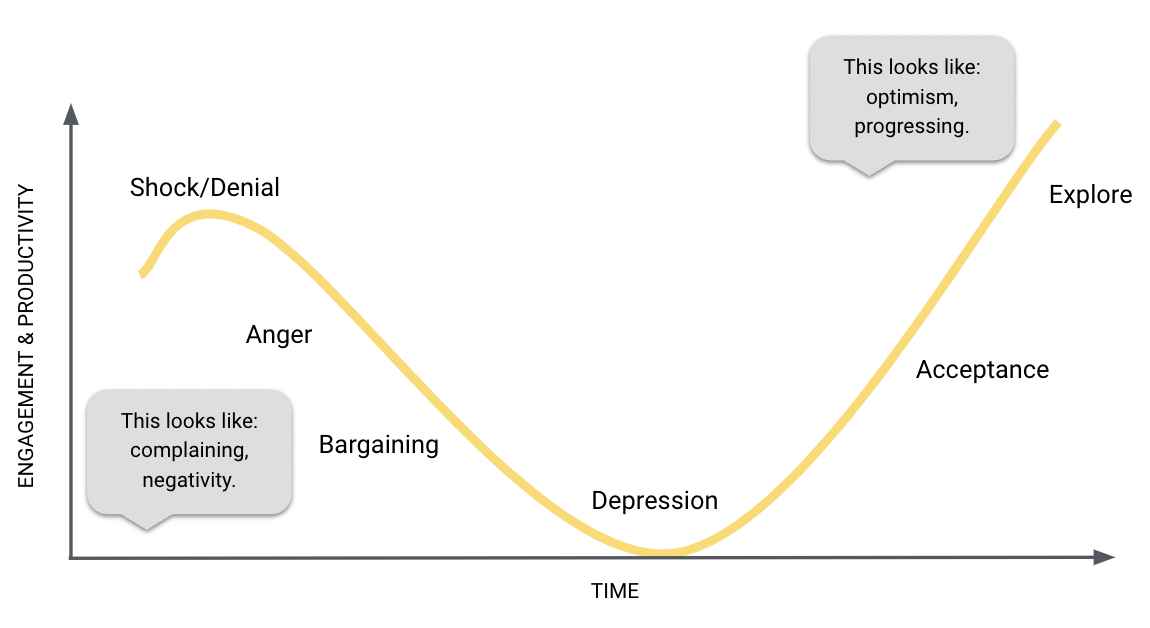All change, big or small, requires us to adjust our expectations.
YOU wiLl LEARN
In this module, you’ll learn how to support yourself, and those in your care, during times of change.
We’ll cover:
Psychology of change.
What your team needs during change.
Growing your team's tolerance for change.
KEY CONCEPTS in this module
Let’s get started.
Changing your understanding of what to expect, and equally, what is expected of you during a change, takes time to get your head around.
On paper, a change might not seem like a big deal. In reality, we’re stretching our understanding to take on new information.
Specifically:
Processing new information and making sense of what it means for you.
Adjusting your understanding of what is expected of you.
Managing your mental and emotional capacity, as change appears.
This is why change affects people so differently.
Why is having a relationship with change useful at work?
When you find change hard to process, like we all do at times, it creates instability in the business.
When you process change well, you provide greater stability to the business and those around you.
As a result, if you are able to demonstrate that you have capacity to adjust to change, you are more likely to be considered for future opportunities.
How long does it take for someone to embrace change?
It’s actually not ‘change’ we want someone to embrace. It’s a new habit, behaviour or way of thinking.
And studies tell us that new habits can take between two and eight months to stick, depending on the person.
Embracing change requires us to think or behave differently. And that takes time.
The psychology of change.
Psychiatrist Elisabeth Kübler-Ross is credited with this model for how we now process change.
It suggests we process change in the following stages:
Stage one: shock.
Stage two: acceptance.
download accompanying materials
Stage one: shock.
In stage one, we are confronted with the idea that things will change. In this stage, we may experience shock, frustration, a sense of hopelessness, or that change is happening ‘to us’.
We typically experience feelings of:
Shock
Anger
Bargaining
Depression
We are unable to move forward: only stand still or look back.
Stage two: acceptance.
In stage two, we can move forward.
We typically experience things like:
Being open to exploring a new future.
Considering new alternatives to the status quo.
Figuring out what the new world could look like with the change.
Reflecting on what we can now do differently.
Considering the benefits of the change.
Once someone is in stage two, it’s relatively straightforward to help them grow their capacity for change.
Let’s look at getting them to that point.
Managing an employee in stage one.
What happens when people are in stage one?
In stage one people may complain, be negative, gossip, go silent and stop being effective.
They are overwhelmed. They may also have limited emotional capacity to get their heads around it.
As a result, finding ways to problem solve or consider new ways of doing things may feel hard.
In this stage, people may also feel change is happening ‘to them’.
Your job is to remind them that change is happening ‘around them’, and to help them remember they have choice, agency and possibilities in front of them.
To do this, as leader, you can:
Provide certainty (outlined below).
Remind people what is within their control vs out of their control.
Give them support and space.
The more we know what is certain, the more stable we feel.
The less we know what is certain, the more overwhelmed we can feel.
As a leader communicating change, spend time clarifying the answers to these four questions:
What you know for sure in this change.
Be upfront about what is not changing. What is certain for you as a leader? What is not changing?
Examples: what you know for sure is you are staying together as a team. What you know for sure is everyone is required to go through the IT upgrade.
What you don’t know yet.
What is not clear to you yet, as a boss? What do you need to learn more about before you can give a clear answer? Be explicit about what you don’t know yet and make the commitment to sharing the answer when you have more details.
Examples: how this change will impact the team. What this means for your clients.
What does this mean for your/their role?
Be explicit about how this impacts their role. Remember to consider their options (autonomy), their expertise (competence) and relationships (relatedness).
Examples: You might have more responsibility in future. You might work somewhere different. You might work with different people.
What will definitely change and definitely won't?
Be explicit about what will change. This helps people focus on the most useful things to mentally process.
Examples: You will definitely keep working from this office. You will definitely not be using the same software.
Pro tip:
What can help fast track the acceptance of change is that there is a benefit in it for the other person and they avoid losses.
This is because we’re more wired to avoid loss than to move towards gains. This is a phenomenon called ‘loss aversion’.
Being upfront that the benefit is bigger than a potential loss is crucial for people to consider embracing change.
Help your team talk about managing change, as it happens.
TRAFFIC LIGHT FRAMEWORK (EXERCISE).
This exercise helps you talk about change, as it happens, by giving people the language to share their capacity.
In your green zone: you are in your comfort zone. You are efficient, productive and focussed.
In your yellow zone: you are stretched. You may be frustrated, stressed or low on time.
In your red zone: you are at capacity. You may be stressed, on a deadline or feel overwhelmed.
Reflect on the above:
What ‘zone’s’ do you go through at work?
What are the circumstances?
What are you craving?
Is that something you can give yourself? Is it something others could help you with?
Completing and sharing this exercise with your team gives them a shared language to talk about how they are experiencing change.
download accompanying materials
Circuit breakers shift us between zones (EXERCISE).
A circuit breaker is anything that gives you mental space. As a result, you gain perspective to be able to problem solve.
Circuit breakers can be as small as a break, or as big as a holiday.
Examples:
Walk around the block.
Time off work to mentally reflect.
Space between meetings.
Headphones to escape mentally.
Booking a staycation.
Finding something to look forward to.
download accompanying materials
Getting your team ‘out of red’.
When your team members are in the red, they may need two things: space and support.
Here are examples.
Space to process what is happening.
This might look like time away from you to discuss with their family or loved ones, or space away from business as usual to reflect on what this change means for them.
Support to help make sense of what is happening.
This might look like spending time with you to discuss their options and experience stability, or connecting with other colleagues to figure out how they feel about what’s happening.

